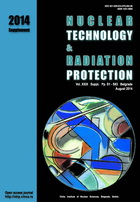
GAMMA-RAY IRRADIATION TESTS OF CMOS SENSORS USED IN IMAGING TECHNIQUES

Vol.
XXIX, Suppl., Pp. S1-S63
August 2014
UDC 621.039+614.876:504.06
ISSN 1451-3994
Pages: S14-S19
Authors: Salvatore G. Cappello, Calogero Pace, Aldo Parlato, Salvatore Rizzo,
and Elio Tomarchio
Abstract
Technologically-enhanced electronic image sensors are used in various fields as diagnostic techniques in medicine or space applications. In the latter case the devices can be exposed to intense radiation fluxes over time which may impair the functioning of the same equipment. In this paper we report the results of gamma-ray irradiation tests on CMOS image sensors simulating the space radiation over a long time period. Gamma-ray irradiation tests were carried out by means of IGS-3 gamma irradiation facility of Palermo University, based on 60Co sources with different activities. To reduce the dose rate and realize a narrow gamma-ray beam, a lead-collimation system was purposely built. It permits to have dose rate values less than 10 mGy/s and to irradiate CMOS Image Sensors during operation. The total ionizing dose to CMOS image sensors was monitored in-situ, during irradiation, up to 1000 Gy and images were acquired every 25 Gy. At the end of the tests, the sensors continued to operate despite a background noise and some pixels were completely saturated. These effects, however, involve isolated pixels and therefore, should not affect the image quality.
Key words: imaging technique, CMOS image sensor, gamma irradiation
FULL PAPER IN PDF FORMAT (1,22 MB)